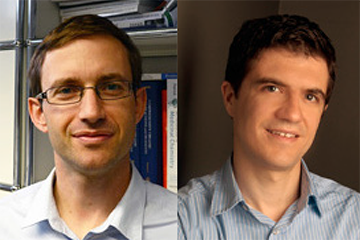Recently, work between the labs of Jérôme Waser and Beat Fierz (EPFL) was published in Chem: the paper describes a cysteine bioconjugation methodology for the introduction of hypervalent iodine compounds onto biomolecules. This bioconjugation allows also for a “doubly orthogonal” functionalization via strain-release-driven cycloaddition and Suzuki-Miyaura cross-coupling. We had the opportunity to discuss with both group leaders about this approach from a chemical stand point and about the state-of-the art of bioconjugation methodologies.

The availability of chemical tools that allow scientists to edit biomolecules, like proteins, with atom-level resolution is one of the holy graal quests of chemical biology. A new method for modifying cysteine-containing biomolecules on peptides and proteins uses hypervalent iodine reagents. These are very versatile reagents allowing several reactions awaiting expansion to biomolecule labelling to modify cysteines on peptides and proteins. The potential of the various existing hypervalent iodine reagents for bioconjugation methodologies has been successfully proved in the past by the group of Jérôme Waser through fruitful collaborations within the NCCR Chemical Biology.
You have been working on different strategies to chemically modify proteins. Which represent today the state-of-the-art? Where lay the limitations?
Jérôme Waser: This field of research is new for us, but as newcomer I have the impression there are two main strategies: the functionalization of natural or non-natural amino acids. The first one is convenient, as the proteins are easily available, but the selectivity of the reaction is a major issue. The second one can be perfectly selective through the use of bioorthogonal reactions, but requires biotechnology to introduce the non-natural amino acids, which can be time-consuming and requires expertise.
As a chemistry lab, we have focused on the first approach, in particular based on cysteine modification. It is already the most established strategy for natural amino acids, with well-established techniques, such as Michael addition (maleimide) or alkylation (iodoacetamide derivatives), but there are still many limitations such as bioconjugate stability, selectivity against other amino acids or reagent stability. We have discovered the unique reactivity of hypervalent iodine reagents with cysteine, which allowed us to address several of these issues. The functionalization of other amino acids is less advanced, and we are also working on this challenge.
Cysteine bioconjugation strategy allows to edit biomolecules, but one important limitation may be the ease to be performed by a non-chemist expert. How complex is it for a non-chemist to apply your cysteine bioconjugation methodology and its post Suzuki-Miyaura cross-coupling?
Jérôme Waser: The current state-of-the-art is very different for the two steps. The cysteine bioconjugation methods is extremely easy. It is just a mix and shake procedure which works very well under standard conditions. The reagent itself requires chemical expertise to be accessed, but we are happy to provide it. It is easy to perform by non-experts. Unfortunately, the Suzuki-Miyaura step is not yet at this stage. Currently, we need to optimize the conditions for each new biomolecule, which is obviously not practical. Therefore, developing more user-friendly general conditions for this second step will be an important topic of research in our lab in the future.
Beat Fierz: The main limitations are that it is difficult to direct a chemical reaction to a particular functional group on a protein. Proteins contain a lot of similar functional groups, e.g. amines, carboxylic acids etc. In nature, enzymes are able to specifically modify particular amino acid residues, as they employ molecular recognition to catalyse their reaction to a defined site. For chemical introduction of modifications, we generally lack catalysts that show such selectivity. Therefore, we use methods such as solid phase peptide synthesis, to build up protein sequences step-by-step. This allows us total chemical control. As peptide synthesis however breaks down after 50 – 100 amino acids, modifying larger proteins require connecting expressed proteins and synthetic peptides. Alternative methods include the genetic introduction of amino acids that show specific reactivity. Cysteine is of particular use, as it is quite rare naturally and can be specifically modified (as showed in our Chem paper). This then allows the site-specific introduction of functional groups.
Has a double labeling probe been previously described? Which areas would be crucial to apply your double labelling approach? In the development of dual-drug antibody-drug conjuguates (ADC) for example?
Jérôme Waser: There are certainly mainly doubly labelling probes described in the past, but few only have this type of double orthogonality (meaning the introduced groups are orthogonal to each other, and also to the functionalities present in biomolecules). Of course, such probes could be designed by using other known bioorthogonal groups, and the true value will depend on the versatility of the unique hypervalent iodine compound introduced in this step. As the Suzuki Miyaura coupling is not very convenient for the moment, we certainly need more fundamental research in this area, and maybe discover other easy to run bioorthogonal reactions. This will be necessary for the reagent to be broadly applied. Concerning applications, the ones you name would be interesting, but this question is better addressed to Beat Fierz: as synthetic chemists, we sometimes lack the know-how for identifying the most exciting applications. It is why the NCCR Chemical Biology network is very important for us: we are always happy to collaborate with more applied chemical biology groups!
Beat Fierz: The applications of the double orthogonal labeling methods are indeed varied. First, the fluorescence stabilizer can be combined with any fluorophore, improving over previous methods that required individual syntheses for each fluorophore. Second, the dual handle allows combination between different functional groups for protein detection (fluorophores), affinity purification (biotin, or similar tags), for the mediation (small molecule ligands) or detection (photo-crosslinkers) of protein-protein interactions. Thus, protein reagents can be produced that can be used to probe various functions in one reaction.
Reference: Romain Tessier, Javier Ceballos, Nora Guidotti, Raphael Simonet-Davin, Beat Fierz, Jérôme Waser, “‘Doubly orthogonal’ labeling of peptides and proteins“, Chem, Volume 5, Issue 8, 2243-2263, 2019.

Leave a comment
The editors reserve the right not to publish comments or to abridge them.